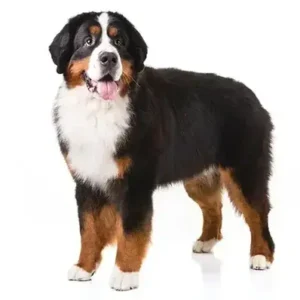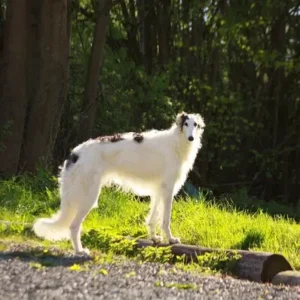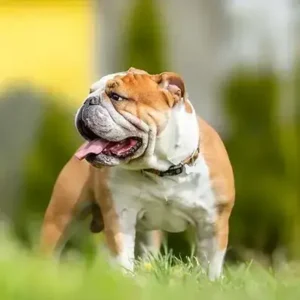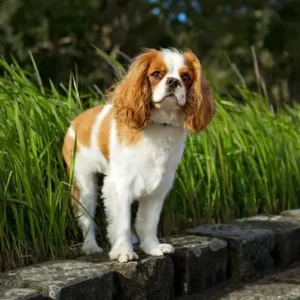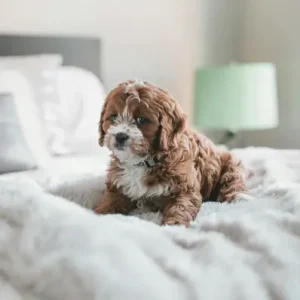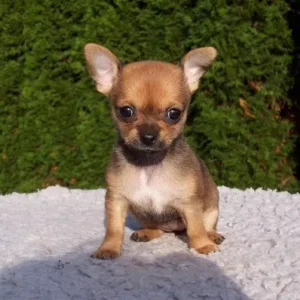Shiba Inu History/Origin
The Shiba Inu originated in Japan along with larger breeds like the Akita, Shikoku, Kai Dog, Hokkaido, and Kishu. It was primarily used as a hunting dog to flush out small game and birds. There are several theories about how the Shiba Inu got its name.
One theory is that “Shiba” means “brushwood,” referring to the bushes where they hunted. Another suggests the name comes from their fiery red coat, similar to autumn brushwood leaves. A third idea is that an archaic meaning of “shiba” refers to their small size.
World War II nearly wiped out the Shiba Inu population. Many dogs perished in bombing raids or succumbed to distemper in the post-war years. After the war, Shibas were brought from remote countryside areas, and breeding programs were established.
The remaining dogs were interbred to produce the modern Shiba Inu. The Japanese Kennel Club was founded in 1948, and the breed standard was drafted by Nihon Ken Hozonkai. This standard was later adopted by both the Japanese Kennel Club and the Federation Cynologique Internationale.
Shiba Inu History- Source: AKC.org
The first Shiba Inu was imported to the United States by an American service family in 1954. However, little else is documented about the breed in the U.S. until the 1970s. The first American litter was born in 1979.
The Shiba Inu was recognized in the American Kennel Club Miscellaneous Class in 1993 and gained full status in the Non-Sporting Group in 1997.
Shiba Inu Personality
The well-bred Shiba Inu is good-natured, alert, and bold. He is strong-willed and confident, often having his ideas about things. Loyal and affectionate with his family, the Shiba Inu tends to be suspicious of strangers. He doesn’t share well and may guard his food, toys, or territory aggressively.
This purebred dog is smart but training a Shiba Inu is different from training a Golden Retriever. While a Golden Retriever is eager to come when called, the Shiba Inu will come when he feels like it—or not.
- Temperament
The Shiba Inu is renowned for its spirited temperament, characterized by a unique blend of independence, curiosity, and loyalty. While they are affectionate with their families, they also possess a certain aloofness towards strangers. This reflects their ancient lineage as hunting dogs in Japan.
Shibas are highly intelligent and agile, traits that make them both charming companions and formidable problem solvers. Their playful demeanor and keen sense of adventure ensure that life with a Shiba Inu is always full of surprises and boundless energy.
- Potential challenges
The Sahiba Inu, a relatively rare breed, may present a few challenges to potential owners. Firstly, their high energy levels demand consistent exercise and mental stimulation to prevent boredom and destructive behavior. With proper outlets, they may avoid excessive barking or digging.
Their strong prey drive poses challenges, as they could chase smaller animals if not properly trained and socialized. Additionally, their independent nature makes training more challenging, requiring patience and persistence from their owners.
Shiba Inu Physical Appearance
The Shiba Inu is one of the dog breeds which is small with a well-proportioned head. It has black lips and a nose, and its ears are shaped like triangles. Its eyes are also a bit triangular. The front legs are straight, and they usually have dewclaws, which can be taken off if the owner wants. The Shiba Inu’s tail is carried over its back and is thick at the base.
- Size
The Shiba Inu typically stands between 14.5 to 16.5 inches in height and weighs approximately 23 pounds. They are considered a medium-sized breed with a compact build. These dogs are known for their alert and agile nature.
- Coat color
The Shiba Inu has a thick double coat, giving it a Teddy Bear appearance. The outer coat is stiff and straight, while the undercoat is soft and dense. Shiba Inu coats can be orange-red, urajiro (cream to white on the underside), or sesame (black-tipped hairs on a rich red background). They may also have white markings on the tip of the tail and the forelegs and hind legs.
Shiba Inu Gender Differences
- Size differences
Adult male Shiba Inus typically stand 5 to 16.5 inches tall and weigh around 23 pounds. Female Shiba Inus generally have a height of 5 to 15.5 inches and weigh about 17 pounds.
Male and female Shiba Inu -Source: Layla Glez
- Temperament Differences
Male Shiba Inus are generally friendlier and more social than females, but they can exhibit aggression, especially towards other dogs if not properly trained or neutered. Males are confident, independent, and typically bolder than females.
Female Shiba Inus, on the other hand, tend to be aloof with strangers and are more cautious and less bold compared to males. They are also more independent and less likely to cuddle, often being compared to cats. While females are generally less aggressive than males, unspayed females may show more aggression toward other female dogs and tend to be more territorial.
Shiba Inu Feed/Nutrition
Feed your Shiba Inu 1/2 to 1.5 cups of high-quality dry food daily, divided into two meals. The exact amount depends on your dog’s size, age, build, metabolism, and activity level. Active dogs will require more food than those that are less active.
The quality of the dog food is also important; higher-quality food provides better nutrition, meaning you’ll need to feed less. To maintain your Shiba Inu’s health, measure their food and feed them twice a day instead of leaving food out all the time. You can also offer cucumber as a low-calorie treat, which is hydrating and safe for dogs when served in moderation.
Shiba Inu Health
Shiba Inus are generally healthy, but like all breeds, they’re prone to certain health conditions. Not all Shiba Inus will get these diseases, but it’s important to be aware of them if you’re considering this breed. If you’re buying a puppy, find a reputable breeder who can provide health clearances for both your puppy’s parents. Health clearances prove that a dog has been tested for and cleared of specific conditions.
- Allergies: Allergies are common in dogs, including Shiba Inus. There are three main types of allergies: food allergies, treated by eliminating certain foods from the dog’s diet; contact allergies, caused by reactions to topical substances such as bedding, flea powders, dog shampoos, and other chemicals; and inhalant allergies, caused by airborne allergens like pollen, dust, and mildew. Treatment varies depending on the cause and may include dietary changes, medications, and environmental adjustments.
- Cancer: Symptoms of cancer in dogs include abnormal swelling, sores that do not heal, bleeding from any body opening, and difficulty breathing or eliminating. Treatments include chemotherapy, surgery, and medications.
- Epilepsy: Epilepsy can be inherited and causes seizures ranging from mild to severe. Seizures might manifest as unusual behaviors like frantic running, staggering, or hiding. While seizures can be frightening, dogs with idiopathic epilepsy often have a good long-term prognosis. Seizures can also be caused by metabolic disorders, infectious diseases, tumors, poisons, or severe head injuries.
- Patellar Luxation: This condition involves the dislocation of the kneecap, causing pain. It can be crippling, but many dogs live relatively normal lives with it.
- Hypothyroidism: A thyroid gland disorder that can lead to conditions like epilepsy, hair loss, obesity, lethargy, and skin issues. Treatment usually involves hormone replacement medication and a special diet to manage symptoms and maintain overall health.
- Progressive Retinal Atrophy: PRA is a group of eye diseases causing gradual retinal deterioration. Dogs initially become night-blind, then lose daytime vision. Many dogs adapt well to limited or complete vision loss if their surroundings remain unchanged.
- Hip Dysplasia: This hereditary condition involves the thighbone not fitting snugly into the hip joint, potentially causing pain and lameness. Arthritis can develop as the dog ages. X-ray screening for hip dysplasia is done by the Orthopedic Foundation for Animals or the University of Pennsylvania Hip Improvement Program. Dogs with hip dysplasia should not be bred. When buying a puppy, ask the breeder for proof of the parents’ hip dysplasia tests.
Shiba Inu Care and Grooming
The Shiba Inu thrives in a home with a fenced yard where he can play, walk, or jog. As an active breed, he needs space to burn off energy. Early socialization is crucial to prevent timidity or aggression, as Shiba Inus can be wary of strangers and aggressive towards other dogs.
The Shiba Inu sheds moderately year-round and heavily twice a year, resembling a snowstorm on your furniture and clothing. Grooming is easy as they are naturally clean and odor-free, but weekly brushing is needed to remove dead hair and distribute oils, increasing during heavy shedding.
Occasional baths are necessary but not too frequent to avoid drying out their skin and coat, with many owners bathing them every three to four months. Brush their teeth two to three times a week, and trim their nails monthly or as needed. If you hear nails clicking on the floor, they’re too long.
Check ears weekly for redness or odor, cleaning with a damp cotton ball. Start grooming habits early, making it a positive experience with praise and rewards. Regular grooming helps identify health issues like sores, rashes, or infections early.
Additionally, potty training your puppy from a young age is essential to maintain a clean home and establish good habits.
Shiba Inu Rescue Groups
Several rescue groups specialize in finding homes for Shiba Inus. These organizations provide care, rehabilitation, and rehoming services for Shiba Inus in need.
Shiba Inu Price
Prices typically range from $1,500 to $3,000, depending on pedigree and breeder reputation. Ensure to choose a reputable breeder who provides health clearances and a nurturing environment for the puppies.
Interesting Facts
- Despite their cute and cuddly appearance, Shiba Inus are often said to have a personality more akin to that of a typical cat.
- In Japan, the Shiba Inu is considered a national treasure and is protected as a cultural heritage.
- One notable example is the popular animated series “Shirokuma Cafe” where a Shiba Inu named “Shirokuma“.
- Miley Cyrus has owned a Shiba Inu.
- They have been featured in the Breed Judging Show 2023.
Best For
Shiba Inu is best suited for owners who value their independent spirit and are dedicated to providing them with proper training and socialization. They thrive in environments where they have space to play and explore, making fenced yards ideal. Active individuals or families who enjoy outdoor activities may find a Shiba Inu to be a compatible and adventurous companion.
Top Names
| Male Shiba Inu Names | Female Shiba Inu Names |
| Winston | Bella |
| Murphy | Daisy |
| Cooper | Luna |
| Baxter | Molly |
| Teddy | Sadie |

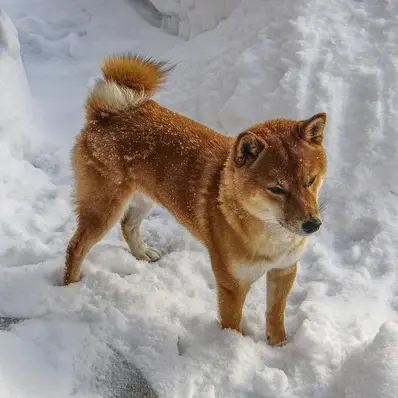







 Akita – Source:
Akita – Source:  Hokkaido- Source:
Hokkaido- Source:  Kishu – Source:
Kishu – Source:  Shiba Inu History- Source:
Shiba Inu History- Source: 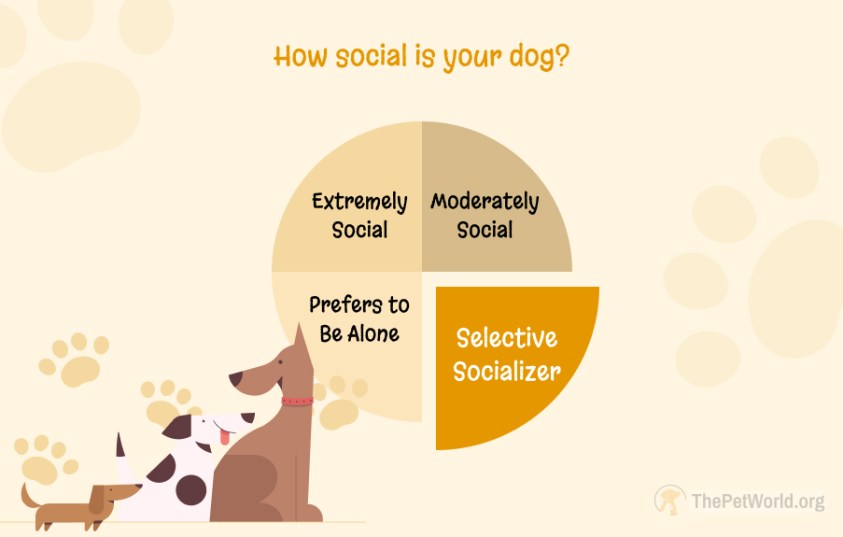

 Orange-red Shiba Inu – Source:
Orange-red Shiba Inu – Source:  Black and White Shiba Inu – Source:
Black and White Shiba Inu – Source:  Male and female Shiba Inu -Source:
Male and female Shiba Inu -Source: 


